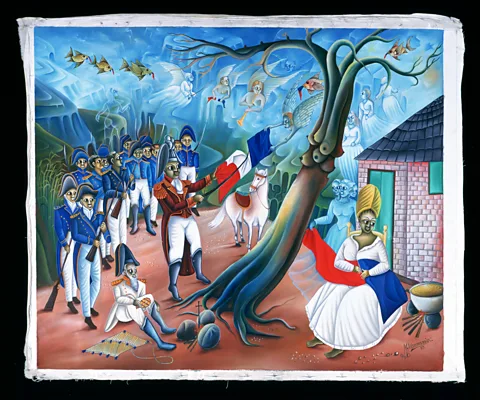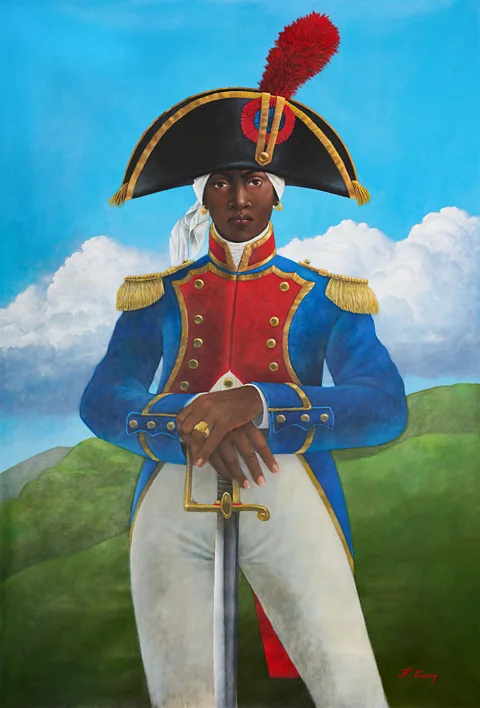
'In some cases, it was the women who were fiercest in the fight': The female freedom fighters of the Haitian Revolution
Contemporary paintings celebrate the brave women who fought fiercely alongside the men in the Haitian revolution of the 18th Century.
'In some cases, it was the women who were fiercest in the fight': The female freedom fighters of the Haitian Revolution
2 days ago
Emi Eleode

(Credit: Courtesy of the artist, Francois Cauvin)
Contemporary paintings celebrate the brave women who fought fiercely alongside the men in the Haitian revolution of the 18th Century. How did they contribute, and why have their stories been buried for so long?
On the night of 23 August 1791 in Cap-Français, on the north coast of Saint Domingue (present-day Haiti), fires raged on the plantations. The enslaved set fire to the buildings and fields, and killed their masters. It was the start of the Haitian Revolution, the only known uprising of enslaved people in history that led to the founding of a state that was free from slavery.
Meanwhile, on the other side of the Atlantic in France, news was fast spreading about the uprisings. The wealthy ruling elite and those with a monopoly in the transatlantic slave trade were growing anxious. They began to realise that their days of subjugating the enslaved population for profit were coming to an end. The coordinated attacks was the beginning of an armed resistance that sprung up across the country in the following years.
The enslaved rebellions ultimately led to the previously unthinkable; the dismantling of the colonial system and the declaration of Haiti's independence in 1804. It was "the first successful large-scale revolt by enslaved people in history", and the country became the first free black republic in the world, and the first independent Caribbean state.
History mostly remembers the exploits of male freedom fighters of the Haitian Revolution. Figures such as its leader, General Toussaint Louverture; Jean-Jacques Dessalines, who became the first ruler of an independent Haiti; Dutty Boukman who was leader of the Maroons and a vodou priest, or houngan; the first and only King of Haiti Henri Christophe, and others. Their stories have been chronicled and commemorated through time.
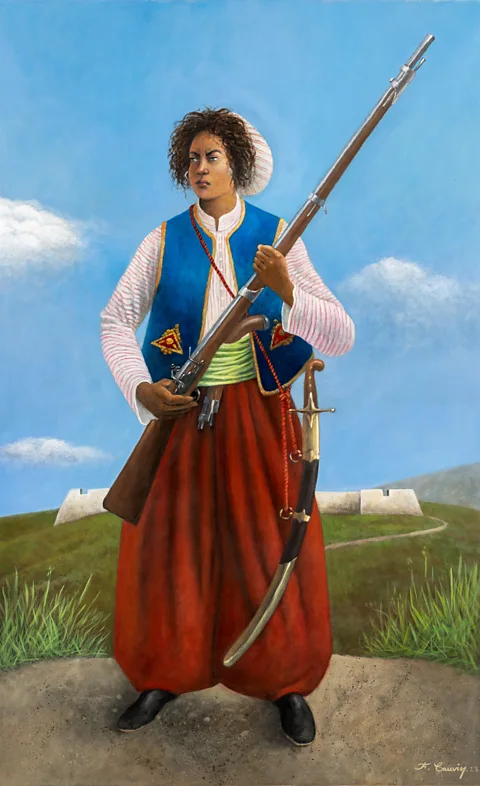
Marie Jeanne Lamartiniére, portrayed by artist Francois Cauvin, wore male uniform and fought alongside men in the revolution (Credit: Courtesy of the artist, Francois Cauvin)
Yet there were also women who had key roles in the fight for Haiti's independence. Much of their history is unknown in the mainstream, or underrepresented and overlooked due to the lack of documentation and records of their activities. However the stories we do know of women including Sanité Bélair, Cécile Fatiman, Marie-Jeanne Lamartiniére, Catherine Flon, Suzanne Simone Baptiste Louverture and more, detail their determination, bravery and dedication to the cause against all odds.
There's also a lack of visual evidence of these women. However, contemporary artists Richard Barbot and François Cauvin – both Haitian – have reimagined them, providing faces to the names. Cauvin's painting of Lamartiniére will be part of The Fitzwilliam Museum exhibition Resistance, Revolution and Reform: Cambridge and the Caribbean in the Age of Abolition in 2025.
Dr Crystal Nicole Eddins, associate professor of sociology at the University of Pittsburgh and author of Rituals, Runaways, and the Haitian Revolution: Collective Action in the African Diaspora, tells the BBC that women employed various tactics of resistance, from overt action, to working quietly behind the scenes. Some, including Bélair and Lamartiniére, were fighting on the frontlines. "We know that women were taking up arms alongside men. Women from African societies held a wide range of social roles, some of which were militaristic, in addition to the fact that women were also labouring on plantations, doing the same work as men. So it follows that they were fighting the same fight."
In some cases, historians have said that it was the women who were the most fierce in their fight – Dr Crystal Nicole Eddins
There were healers and nurses like Catherine Flon – who is mostly known for being a seamstress, and is said to have sewn the newly independent Haiti's first flag – as well as educators, spies and saboteurs who used guerilla tactics to sabotage resources, including water supplies, of their enemies. Eddins explains that women also contributed to more gendered roles such as growing and providing food for the rebel armies and their communities.
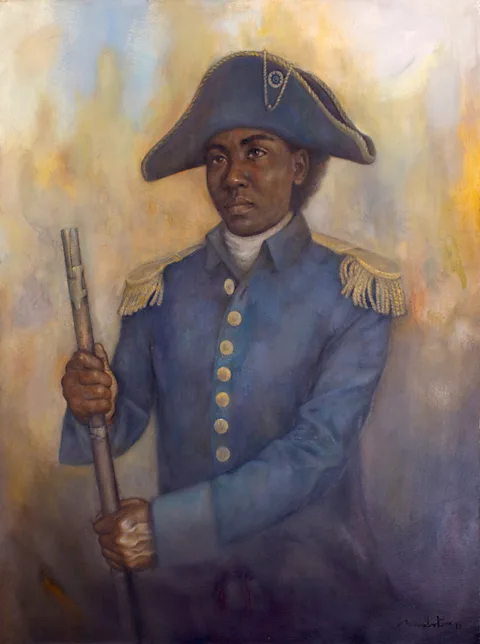
Sanité Bélair, depicted by Haitian artist Richard Barbot, was a revolutionary who led the charge at Saint-Domingue (Credit: Courtesy of the artist, Richard Barbot)
Sanité Bélair was a Haitian revolutionary leader who served in Toussaint Louverture's army. She rose through the ranks, first as a sergeant then a lieutenant, leading the charge in the Saint-Domingue expedition. Alongside her husband Charles Bélair, another lieutenant in the army, they were eventually captured and executed on orders from Napoleon. Bélair's legacy is commemorated with her portrait on the Haitian 10 gourdes banknote, created in 2004 as part of a series celebrating the 200th anniversary of Haiti's independence.
Less well known were the vodou priestesses (mambos) and spiritually powerful women like Cécile Fatiman, who provided "protection spells" to the rebels, and refused to give up information about their location. They also used their traditional knowledge of herbal medicine to poison slave owners.
Born to an enslaved African woman and a Corsican prince, Fatiman was a prominent mambo and revolutionary who is also said to have created networks of communication transporting information across the plantations. She lived to a remarkable 112 years old.
Marie-Jeanne Lamartiniére was a Haitian soldier and nurse who is celebrated not only for her courage but also for her knowledge and strategy on the battlefield. Wearing male uniform and fighting alongside the men, she was highly respected. Lamartiniére was a key figure in the major Battle of Crête-á-Pierrot in 1802 against French forces.
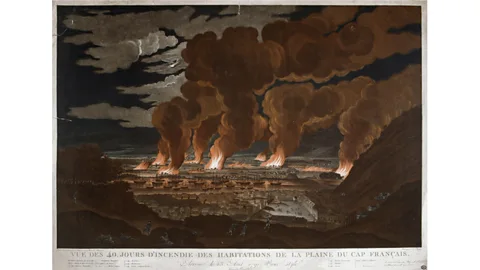
The Haitian Revolution began with the uprising of enslaved people in the northern plains of Saint-Domingue in 1791 (Credit: Alamy)
Women were not exempt from the punishments meted out for participating in the revolution, and they suffered the same brutal fates as men. Bélair was famously known to have refused the blindfold before being executed alongside her husband by the French. "She's described by earlier historians' accounts and in CLR James's book The Black Jacobins, as having been a really brave woman who promoted the fight for independence," says Eddins.
With the few details we know of Bélair and other women, chroniclers have written about their bravery and determination for the liberation cause. "In some cases, historians have said that it was the women who were the most fierce in their fight." They subverted colonial oppressions, and, in the face of adversity, fought for agency within their communities and society at large.
